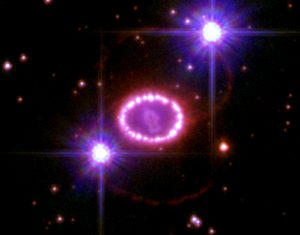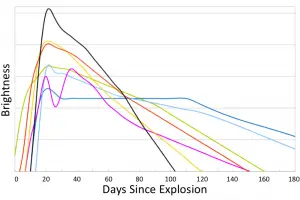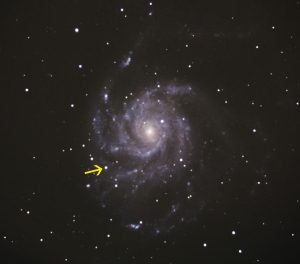
I understand stars are millions of light years away and it takes a long, long time for the light of say a star exploding to reach us. We have pictures of stars exploding 50 years ago.
Why are those stars still exploding? Do they explode in slow motion?? Also, why don’t we see galaxies turning?
Thanks for your question!
First off, some stars are only a few or tens of light years away, but many more are millions or even billions of light years away as you said. Second, you’re right in saying that the light from these stars takes a long time to get to us and that the vast majority of exploding stars, known as supernova, that we see are indeed tens of millions of light years away from us and thus their light takes tens of millions of years to get to Earth. Third, in addition to images from 50 years ago, we actually have images of supernova, and the galaxies that they exploded in, going back to the early 20th century and we’ve been taking pictures of supernova and their host galaxies ever since then. Old images of galaxies look very much like newer images because galaxies take a really long time to rotate. The Sun, for example, takes about 250 million years to complete one orbit around the Milky Way Galaxy. So in 50, or even 100, years we won’t notice any rotation of or movement in other galaxies.
As for the explosions themselves, they indeed do not take long! Most supernova take a fraction of a second up to a couple seconds to explode. What we observe as the actual supernova is the light and energy that come out of that explosion. Typical supernova get brighter during the first 3 weeks or so after that very fast explosion. After that time, most supernova start to slowly fade away and eventually fade out of sight after about a few months. The image below shows “light curves” of a few different types of supernova. A light curve is simply a graph of the brightness of a supernova (on the vertical, y-axis) versus time or days since the explosion (on the horizontal, x-axis). I won’t get into what the different types of supernova are (I’ll save that for a different Ask an Astronomer question!), but you see that most of them take about 3 weeks to hit their maximum brightness and then fade away over the next few months or so.

Now if a supernova is very close by, we can continue to observe it for a longer period of time. It’s still fading over the months and years following the explosion, but if it’s nearby enough, then we can keep taking pictures of it even a few years later. A supernova was discovered in the summer of 2011 in the nearby Pinwheel Galaxy; it’s the bright spot that the arrow is pointing to in the image below, which was taken soon after the explosion in August 2011. This was a very typical supernova, but it and its host galaxy are so close by (a mere 21 million light-years away!) that people are still (as of November 2015) taking images of it.

Another way to observe a supernova for a very long time is if it keeps getting a new boost of energy every once in awhile. This is a rare occurrence, but it does sometimes happen. The situation starts in the decades and centuries before the star explodes. Certain stars, before they explode and go supernova, will “burp-off” chunks of their outer layers and eject them into space. When the star finally goes supernova, the very fast moving material that explodes outward can eventually catch up with and run into these burped off layers. That collision will create heat and light that can keep the supernova bright for years or even decades after the explosion. The oldest supernova I’ve personally ever observed was one of this rare kind of supernova and it was about 25 years old at the time (slightly younger than I was when I observed it!).
So to summarize: stars explode very quickly, in most cases they stay bright enough to observe for a few months to a year or so, but in certain special cases we can keep taking images of the supernova for years or even decades after the explosion.
Dr. Jeffrey Silverman
UT Austin